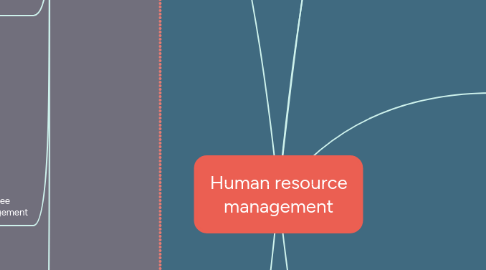
1. Training
1.1. Training and the link with organizational needs
1.1.1. Definition
1.1.1.1. An organization’s planned efforts to help employees acquire job related knowledge, skills, abilities, and behaviors, with the goal of applying these on the job.
1.1.2. Stages of instructional design
1.1.2.1. asses needs
1.1.2.2. ensure readinnes for training
1.1.2.3. Plan training program
1.1.2.4. implement training program
1.1.2.5. Evaluate results of training
1.1.3. Learning management system
1.2. Assessing the need for training
1.2.1. Need assessment
1.2.1.1. need assesment
1.2.1.2. organization analysis
1.2.1.3. person analysis
1.2.1.4. task analysis
1.2.2. Readiness for training
1.3. Planning an effective training program
1.3.1. Objectives of the program
1.3.2. in house or contracted
1.3.3. choice of training methods
1.3.3.1. presentation methods
1.3.3.2. hands on methods
1.3.3.3. group building methods
1.4. Comparing widely used training methods
1.4.1. Training methods
1.4.1.1. classroon & distance learning
1.4.1.2. audiovisual training
1.4.1.3. Computer based training
1.4.1.4. on the job training
1.4.1.5. experiential
1.4.1.6. behavior modeling
1.4.1.7. simulations
1.4.1.8. business games & case studies
1.4.1.9. team training
1.4.1.10. action learning
1.5. Implementing and evaluating a successful training program
1.5.1. Implementing the training program
1.5.1.1. Principles of learning
1.5.1.2. activities that help training
1.5.2. Evaluation methods
1.5.2.1. transfer of training
1.5.2.2. measures of training succes
1.5.3. communities of practice
1.6. describing methods for employee orientation and diversity management
1.6.1. applications of training
1.6.1.1. orientation
1.6.1.2. on-boarding
1.6.1.2.1. compliance
1.6.1.2.2. clarification
1.6.1.2.3. culture
1.6.1.2.4. connection
1.6.2. dicersity training
1.6.2.1. behavior changes
1.6.2.2. constructive solutions to handle barriers
1.6.2.3. cultural immersion
1.7. understanding employee development and how it differs from training
1.7.1. employee development = future
1.7.2. approaches to employee development
1.7.2.1. interpersonal relationship
1.7.2.2. formal education
1.7.2.3. job experiences
1.7.2.4. assessment
1.7.3. how to do employee development
1.7.3.1. promotion
1.7.3.2. enlargement of the current job
1.7.3.3. downward move
1.7.3.4. transfer
2. Compensation
2.1. Pay structure
2.1.1. Pay grade
2.1.2. Pay rates
2.1.3. Pay differentials
2.1.4. Pay ranges
2.2. Incentives
2.2.1. Individual
2.2.1.1. Piecework rates
2.2.1.2. Merit Pay
2.2.1.3. Sales Commissions
2.2.1.4. Standard Hour Plans
2.2.1.5. Bonuses
2.2.2. Group
2.2.2.1. Gainsharing
2.2.2.2. Bonuses
2.2.2.3. Team Awards
2.3. Employee Benefits
3. Critical?
4. Recruitment
4.1. Asses need
4.1.1. What
4.1.2. Why
4.1.3. Who
4.1.4. Where
4.1.5. Steps to follow
4.2. Objectives
4.2.1. Goal setting
4.2.2. Strategic planning
4.2.3. Image
4.3. Values
4.3.1. Mission
4.3.2. Vision
4.3.3. Policies
4.4. Decision
4.4.1. Plan
4.4.2. Supply/demand
4.4.3. Shortage/Surplus
4.5. Skills
4.6. Interna vs external
4.6.1. Who
4.6.2. Advantages
4.7. Selection
4.7.1. Reviewing
4.7.2. Interview
4.7.2.1. Type of interview
4.7.3. Job description
4.7.3.1. Info and documents
4.7.4. Testing
4.7.4.1. Reliability and validity
4.7.4.1.1. Criteria
4.7.4.2. Types of tests
4.7.5. Checking
4.7.5.1. Background and references
4.7.6. Communicate the decision
5. Performance management
5.1. Process
5.1.1. 6 steps
5.1.1.1. Performance result....
5.2. Purpose and criteria
5.2.1. Strategic
5.2.2. Administrative
5.2.3. Developmental
5.3. Comparative, quality....
5.4. Measure performance
5.4.1. Simple ranking, forced distribution...
5.4.2. Scale
5.5. Performance sources
5.5.1. Managers
5.5.2. Customers
5.5.3. Subordinates
5.5.4. Self&peers
5.6. Rating errors
5.6.1. Reduce error
5.6.1.1. Political behavior..
5.7. Provide performance
5.7.1. Performance feedback
5.8. Legal and ethical
5.8.1. Legal requirements
5.8.2. Electronic monitoring
5.8.3. Employee privacy
6. Labor relations
6.1. Turnover
6.1.1. Involuntary
6.1.2. Voluntary
